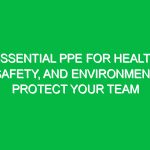Introduction
In the realm of Health, Safety, and Environment (HSE), the term “ISO Safety” refers to the practices and Standards set by the International Organization for Standardization (ISO) that help organizations manage their Safety systems effectively. These standards encompass a range of protocols designed to enhance Workplace Safety, minimize risks, and ensure environmental protection. The relevance of ISO safety in the HSE domain cannot be overstated, as it serves as a framework for organizations to safeguard their employees, comply with legal requirements, and promote sustainable practices.
Understanding ISO safety is crucial for organizations aiming to create a culture of safety. This culture not only protects employees and the environment but also enhances operational efficiency and boosts company reputation. This article will delve into the essential aspects of ISO safety, providing insights, guidelines, and real-world examples that emphasize its significance in fostering a safer HSE environment.
Understanding ISO Safety Standards
ISO safety comprises various standards, the most notable being ISO 45001, which focuses on Occupational Health and safety management systems. This standard provides a framework for organizations to improve employee safety, reduce workplace risks, and create safer working conditions. By implementing these standards, organizations can proactively identify Hazards and mitigate risks, leading to a safer workplace.
Key Aspects of ISO Safety
1. Risk Assessment
A fundamental component of ISO safety is conducting thorough risk assessments. This involves identifying potential Hazards, evaluating the risks associated with those hazards, and implementing Control Measures to eliminate or minimize risk. For instance, a manufacturing facility might identify machinery as a potential hazard. By conducting a risk assessment, they could determine necessary safeguards, such as machine guards or safety Training for operators.
2. Employee Training and Awareness
Employee training is essential in the ISO safety framework. Organizations must ensure that employees are aware of safety protocols and understand their roles in maintaining a safe work environment. Regular training sessions, workshops, and drills can reinforce safety practices. For example, a construction company might conduct monthly safety meetings to keep workers informed about new Regulations and safety Procedures.
3. Incident Reporting and Investigation
Effective incident reporting and investigation systems are vital for continuous improvement in safety practices. When incidents occur, organizations must analyze the root causes and implement corrective actions. This not only prevents recurrence but also fosters a culture of transparency and accountability. A real-life example is seen in the oil and gas industry, where companies meticulously investigate near misses to enhance their safety protocols and prevent future incidents.
4. Continuous Improvement
ISO safety emphasizes the importance of continuous improvement. Organizations should regularly review their safety management systems, assess performance, and make necessary adjustments. Utilizing tools like the Plan-Do-Check-Act (PDCA) cycle can facilitate this process. For instance, after identifying a rise in workplace accidents, a company might revise its safety protocols and training programs to address the issue effectively.
Benefits of Implementing ISO Safety Standards
Adopting ISO safety standards offers numerous Benefits to organizations. These include:
- Reduced Workplace Accidents: A systematic approach to safety helps minimize accidents and injuries.
- Enhanced Compliance: ISO safety standards align with legal requirements, reducing the risk of penalties.
- Improved Employee Morale: A safe workplace fosters a positive work environment and enhances employee satisfaction.
- Operational Efficiency: Streamlined processes and reduced downtime lead to increased productivity.
- Reputation Enhancement: Organizations that prioritize safety can improve their public image and attract top talent.
Identifying Potential Hazards and Risks
While implementing ISO safety standards is crucial, organizations must also be acutely aware of potential hazards and risks that can impact employee safety and environmental Sustainability. Here are some common hazards to consider:
1. Physical Hazards
These include machinery, equipment, and other physical conditions that can cause injury. Regular Maintenance and employee training can help mitigate these risks. For example, ensuring that all machinery is equipped with emergency stop buttons can prevent accidents.
2. Chemical Hazards
Exposure to harmful chemicals can pose significant health risks. Organizations should implement proper handling, storage, and disposal protocols. A well-known instance is the chemical spill at a manufacturing plant that led to severe environmental damage. This incident highlighted the need for stringent chemical Safety Measures.
3. Ergonomic Hazards
Poor workstation design can lead to musculoskeletal disorders. Implementing ergonomic assessments can help identify and address these risks. For example, adjusting workstations to promote proper posture can reduce the likelihood of injuries.
Best Practices for ISO Safety Implementation
To effectively implement ISO safety standards, organizations should consider the following Best Practices:
1. Develop a Safety Policy
A clear safety policy sets the tone for an organization’s safety culture. It should outline safety objectives, responsibilities, and procedures. A well-defined policy not only guides employees but also demonstrates management’s commitment to safety.
2. Engage Employees
Involve employees in safety discussions and decision-making processes. Encouraging feedback can lead to valuable insights and foster a sense of ownership over safety practices. For instance, a retail organization might form a safety committee composed of employees from various departments to solicit input on safety improvements.
3. Conduct Regular Audits and Reviews
Regular audits help organizations assess the effectiveness of their safety management systems. These audits should include both internal and external evaluations. For example, a construction company may invite third-party auditors to review their safety practices and suggest improvements.
4. Leverage Technology
Utilizing technology can enhance safety management efforts. Software tools can streamline incident reporting, track safety training compliance, and manage documentation. A logistics company, for instance, might use a mobile app to allow employees to report hazards in real-time, promoting a proactive approach to safety.
Regulations and Standards Governing ISO Safety
Compliance with regulations is a cornerstone of ISO safety. Organizations must adhere to various legal requirements that govern Workplace Safety. Some of these regulations include:
1. Occupational Safety and Health Administration (OSHA) Standards
In the United States, osha sets forth regulations that organizations must follow to ensure Workplace Safety. ISO 45001 aligns with OSHA standards, providing a comprehensive approach to occupational health and safety.
2. Environmental Protection Agency (EPA) Regulations
For organizations dealing with environmental health and safety, compliance with EPA regulations is imperative. ISO safety standards help organizations meet these requirements while promoting sustainable practices.
3. International Standards
ISO safety standards, such as ISO 14001 for environmental management and ISO 45001 for occupational health and safety, provide a globally recognized framework for organizations to enhance their safety management systems.
Conclusion
In conclusion, ISO safety plays an integral role in creating a safer HSE environment. By implementing ISO standards, organizations can proactively address risks, enhance employee safety, and promote environmental sustainability. The benefits of adopting these standards are manifold, including reduced accidents, improved compliance, and enhanced operational efficiency.
As organizations continue to navigate the complexities of modern workplaces, prioritizing ISO safety is not just a regulatory requirement but a moral obligation. By fostering a culture of safety, organizations can ensure the well-being of their employees and the environment, ultimately contributing to a more sustainable future. Embracing these essential ISO safety tips can pave the way toward a safer, healthier, and more productive work environment.


